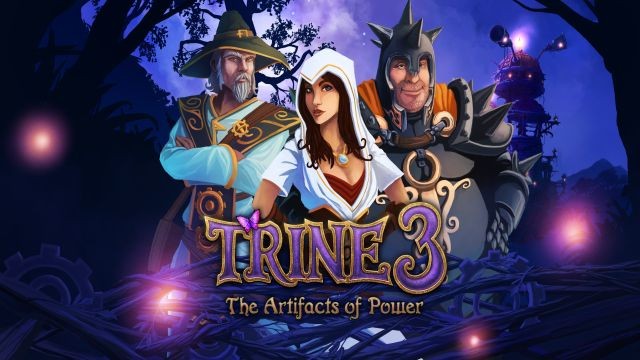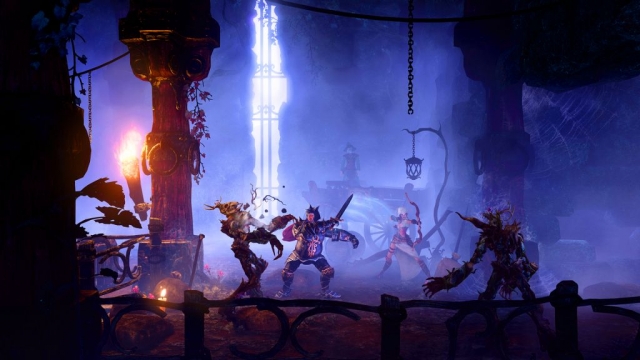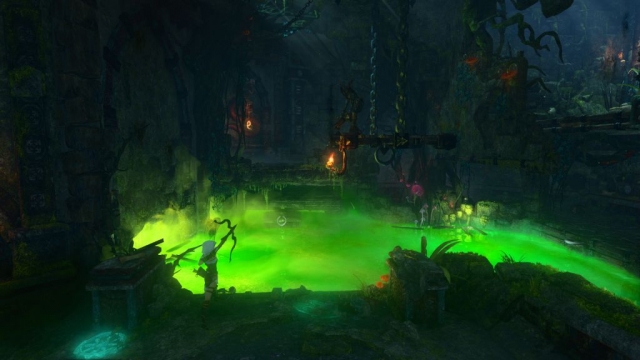Trine 3: The Artifacts of Power

The Good: More Trine goodness,
The Bad: Gutted of much of what made Trine fun.
The Ugly: Iffy implementation of third dimension.
Two iterations ago, Trine was a pleasant little side-scroller which told the story of a thief (Zoya), a wizard (Amadeus), and a warrior (Pontius). Their souls melded by a magic artifact known as the Trine, they proceeded to use their individual skills to solve various physics-based puzzles. In gameplay, the player can call upon any character at any time (unless that character has died) to solve the puzzles, often depending on the player preference. For example, in trying to cross a chasm, wizard could conjure up different physical shapes like boxes and planks to bridge the gap. The thief can shoot a rope arrow and swing across. The warrior can try and jump across – probably not the right character for that puzzle. Orbs scattered through the levels can be collected and spent on upgrades, such as fire arrows for the thief, new conjuring shapes for the wizard, or new attacks for the warrior. Orbs collected by all three characters are pooled, and you can only afford so many upgrades. This played a significant part in the strategy of the game and allowed the play style to be somewhat customized. This gameplay was continued in Trine 2 as well as an expansion pack, all of which I played and enjoyed and reviewed. Anyway, that was then, this is now.
Trine 3 continues the story of our three heroes, although they are now played as both melded, as in the previous Trines, and separate – where the individual characters go on their own adventures, and if they are killed they must restart the level at the beginning. The puzzles remain in the same vein – jumping, timed jumping, pushing buttons, moving boxes around. And, sadly, that’s kind of where the similarity to the earlier Trines ends.
One huge change, and one of the biggest things I’ve got to complain about, is that you no longer collect orbs, but glowing triangles called Trine-angles (yuk, yuk). As near as I can tell, these are good for nothing. They certainly don’t lead to upgrades. I suppose for completists there is the drive to try and collect every single one, earn the associated achievements, but that’s not me. I miss the upgrades. I think I understand perfectly why they did this – the upgrades allowed people to essentially break the physics of the puzzles. There was almost nothing the wizard couldn’t do with a sufficiently teetering tower of conjured shapes, and the thief, able to sink a rope arrow into anything wooden (I seem to recall including the wizard’s conjuring), led to some puzzle solutions that I suspect were not what the designers intended. I thought that was part of the beauty of the game, but it did make some of the parts very easy.
So you’re stuck with the skills the characters start with. At least in this regard, they’re pretty good ones. The warrior can jump and glide a pretty good distance using their kite shield. Kite shield, get it? Not exactly hilarious, but cute. The warrior can also do a shield charge as an attack, which is plenty useful, plus a ground slam to shake things up. The wizard can only conjure a single box now, but they can float them in the air and smash them down causing a lot of damage, whereas in earlier Trines they could only be dropped and fall under gravity, which didn’t do all that much damage. The thief can now only hook a rope arrow off of convenient iron rings, which kind of sucks, and Zoya can also fire a second rope arrow to hook two things together or tether objects (and cut them use later if you wish with another arrow). The thief has definitely gotten the short end of the Trine 3 stick.
The other big change, and I’m not much happier with this one, is that the game now has depth as opposed to a simple side-scroller. This is a kind of geometry that is immediately familiar to console gamers I suppose, but in my PC experience I haven’t seen a great deal of it. I knew right away I was going to have trouble with the 3-D bit. Early on, attacking a boss with the wizard, I was trying to perform the box smash attack, but kept missing because I couldn’t get the depth right. This was complicated by the boss hurling things at me, and I couldn’t tell if I needed to move to avoid getting hit, or if the object in the air was at a different depth as well. The game tries to help with this by having objects in the air cast shadows below them on the ground, but it is hard to pick out the shadows during combat. A further problem is that I could never quite tell where the front of the frame was. I would keep moving the character forward, sometimes finding a hidden space at the front of the screen where Trine-angles reside, and sometimes I would just fall to my death. Rats! Oh, Trine, what was wrong with the 2-D side-scroller you were? On the plus side, characters are now immortal. When one dies, their soul ends up reappearing nearby, and all it takes is for another character to touch it to reincarnate them. Mind you, this can be tricky depending on where the soul appears.
The production values of Trine remain very high. The levels are bright and colorful with a lot of stuff going on – wall sconces blaze with fire, fires smoke, acids fume. The animation has a certain cartoony quality, but it looks beautiful. Voice work and music are likewise great. The writing is good as well, and the story kept my attention. All that said, Trine 3 is a pretty short game – ten or so levels, maybe another dozen side quests. I cleared it all in less than five hours, and I don’t see myself playing it through again even though I didn’t successfully collect all of the Trine-angles (though I might load up Trine 2 and give that another go now that Trine 3 gameplay was so disappointing).
Reviewed By: Phil Soletsky
Publisher: Frozenbyte
Rating: 60%
——————————————————————————–
This review is based on a digital copy of Trine 3: The Artifacts of Power for the PC provided by Frozenbyte.
 Game Over Online
Game Over Online


















